On The Wings of an Eagle: GIGABYTE's X570 I Aorus Pro WIFI Motherboard Tested
by Gavin Bonshor on March 19, 2020 10:00 AM ESTCPU Performance, Short Form
For our motherboard reviews, we use our short form testing method. These tests usually focus on if a motherboard is using MultiCore Turbo (the feature used to have maximum turbo on at all times, giving a frequency advantage), or if there are slight gains to be had from tweaking the firmware. We put the memory settings at the CPU manufacturers suggested frequency, making it very easy to see which motherboards have MCT enabled by default.
For X570 we are running using Windows 10 64-bit with the 1903 update as per our Ryzen 3000 CPU review.
Rendering - Blender 2.7b: 3D Creation Suite - link
A high profile rendering tool, Blender is open-source allowing for massive amounts of configurability, and is used by a number of high-profile animation studios worldwide. The organization recently released a Blender benchmark package, a couple of weeks after we had narrowed our Blender test for our new suite, however their test can take over an hour. For our results, we run one of the sub-tests in that suite through the command line - a standard ‘bmw27’ scene in CPU only mode, and measure the time to complete the render.
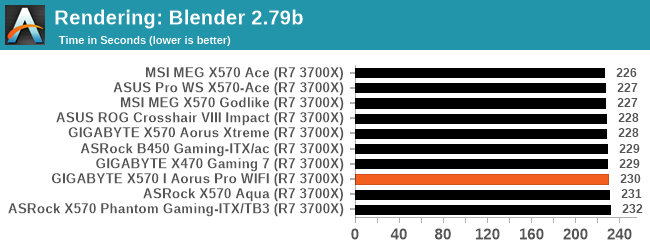
Streaming and Archival Video Transcoding - Handbrake 1.1.0
A popular open source tool, Handbrake is the anything-to-anything video conversion software that a number of people use as a reference point. The danger is always on version numbers and optimization, for example the latest versions of the software can take advantage of AVX-512 and OpenCL to accelerate certain types of transcoding and algorithms. The version we use here is a pure CPU play, with common transcoding variations.
We have split Handbrake up into several tests, using a Logitech C920 1080p60 native webcam recording (essentially a streamer recording), and convert them into two types of streaming formats and one for archival. The output settings used are:
- 720p60 at 6000 kbps constant bit rate, fast setting, high profile
- 1080p60 at 3500 kbps constant bit rate, faster setting, main profile
- 1080p60 HEVC at 3500 kbps variable bit rate, fast setting, main profile
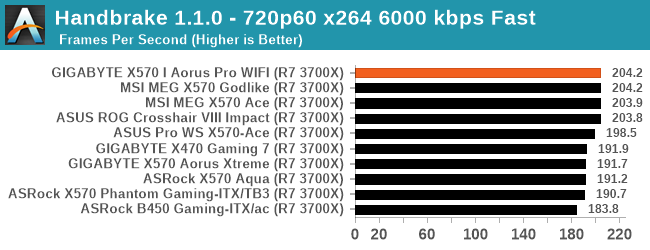
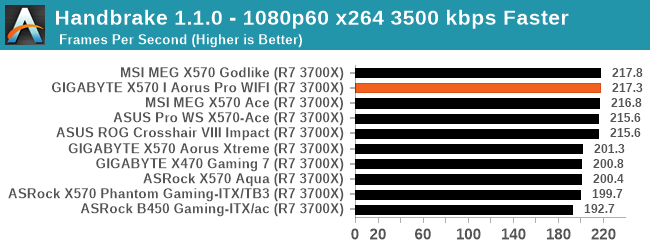
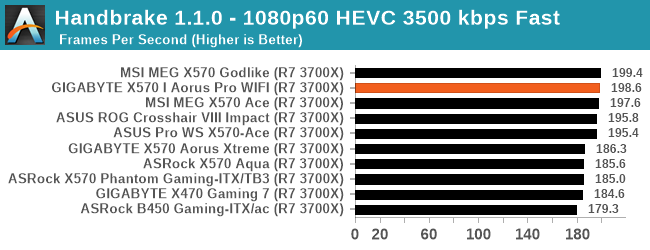
Rendering – POV-Ray 3.7.1: Ray Tracing - link
The Persistence of Vision Ray Tracer, or POV-Ray, is a freeware package for as the name suggests, ray tracing. It is a pure renderer, rather than modeling software, but the latest beta version contains a handy benchmark for stressing all processing threads on a platform. We have been using this test in motherboard reviews to test memory stability at various CPU speeds to good effect – if it passes the test, the IMC in the CPU is stable for a given CPU speed. As a CPU test, it runs for approximately 1-2 minutes on high-end platforms.
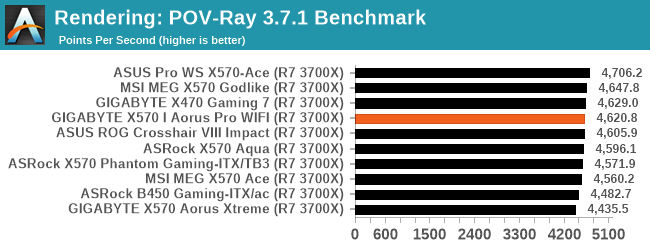
Compression – WinRAR 5.60b3: link
Our WinRAR test from 2013 is updated to the latest version of WinRAR at the start of 2014. We compress a set of 2867 files across 320 folders totaling 1.52 GB in size – 95% of these files are small typical website files, and the rest (90% of the size) are small 30-second 720p videos.
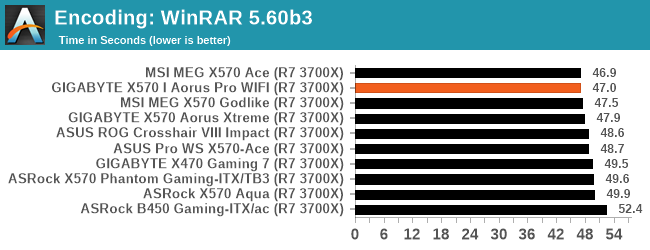
Synthetic – 7-Zip v1805: link
Out of our compression/decompression tool tests, 7-zip is the most requested and comes with a built-in benchmark. For our test suite, we’ve pulled the latest version of the software and we run the benchmark from the command line, reporting the compression, decompression, and a combined score.
It is noted in this benchmark that the latest multi-die processors have very bi-modal performance between compression and decompression, performing well in one and badly in the other. There are also discussions around how the Windows Scheduler is implementing every thread. As we get more results, it will be interesting to see how this plays out.
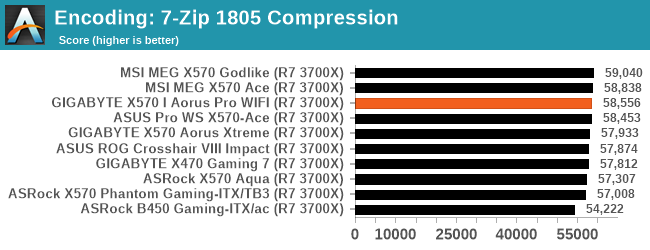
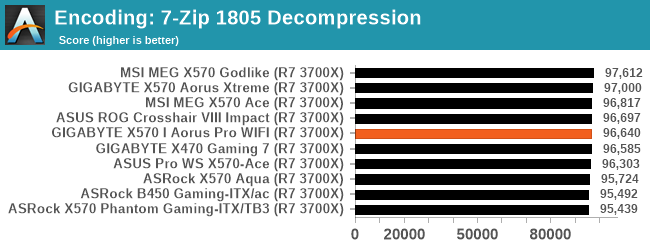
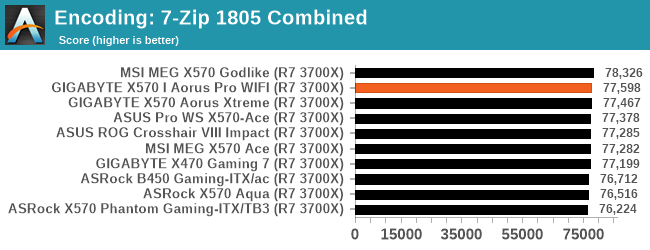
Point Calculations – 3D Movement Algorithm Test: link
3DPM is a self-penned benchmark, taking basic 3D movement algorithms used in Brownian Motion simulations and testing them for speed. High floating point performance, MHz, and IPC win in the single thread version, whereas the multithread version has to handle the threads and loves more cores. For a brief explanation of the platform agnostic coding behind this benchmark, see my forum post here.
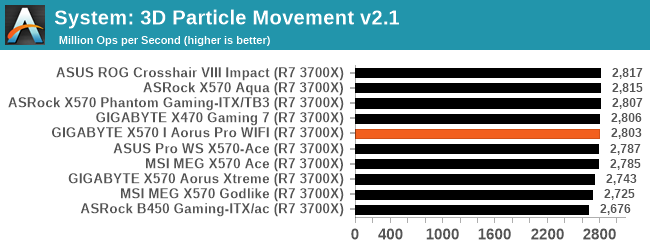
Neuron Simulation - DigiCortex v1.20: link
The newest benchmark in our suite is DigiCortex, a simulation of biologically plausible neural network circuits, and simulates activity of neurons and synapses. DigiCortex relies heavily on a mix of DRAM speed and computational throughput, indicating that systems which apply memory profiles properly should benefit and those that play fast and loose with overclocking settings might get some extra speed up. Results are taken during the steady-state period in a 32k neuron simulation and represented as a function of the ability to simulate in real time (1.000x equals real-time).
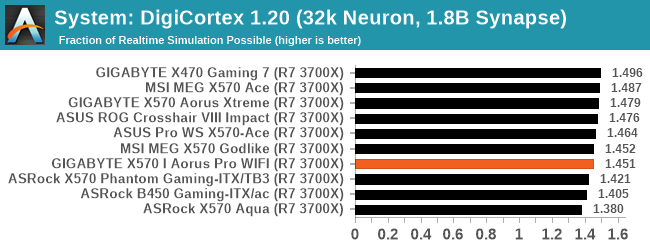










63 Comments
View All Comments
V1tru - Thursday, March 19, 2020 - link
Got it since launch, usefull info:disable bluetooth/wifi powersaving in Windows device setting, or the wireless card will go crazy after standby
sonny73n - Sunday, March 22, 2020 - link
After all these years and Gigabyte motherboards’ drivers still suck.Smack0Lantern - Sunday, March 22, 2020 - link
When did Gigabyte become a designer and manufacturer of ICs for network/RF controllers? Gigabyte doesn’t write the drivers dumbassInTheMidstOfTheInBeforeCrowd - Monday, March 23, 2020 - link
Yeah, and Gigabyte didn't even choose to put these network/RF controllers with those shonky drivers on their motherboard(s). No, they didn't. A ... uh ... armed and dangerous thooth fairy forced Gigabyte to include specifically those ICs on their motherboards. Gigabyte is not the one to blame here!Nephtys - Monday, April 6, 2020 - link
These drivers are provided by Intel, not Gigabyte.joaolx - Friday, May 8, 2020 - link
Thanks for this! I read this before buying the board and came across this issue. I was going crazy with bluetooth disconnecting every minute after waking from sleep and remembered your comment.shabby - Thursday, March 19, 2020 - link
In before the "it's almost a perfect board but it's missing..." crowd.InTheMidstOfTheInBeforeCrowd - Thursday, March 19, 2020 - link
Well, it's not actually missing something, but rather has some superfluous stuff that would befit a board of such compact form factor much better when left out. I am talking about the squirrel cage fan here, which of course is necessary because X570. But then again, a small board such as this hardly benefits from all the I/O options the X570 offers. A chipset nod needing active cooling would be much nicer.Unfortunately, such a chipset doesn't exist presently and one either has to begrudingly accept either squirrel-cage-fan-X570 or B450-pardon-i-meant-B550A, or just refuse to buy this stuff
(Yeah, obviously the latter is me. I am at a point where i want to do a major system upgrade towards Ryzen, but AMDs underwhelming chipset strategy kind of erodes the confidence their latest CPU offerings instill. Not saying that Intel is presenting themselves in a more favourable light. So i am still holding off to see how things develop with regards to both players...)
Slash3 - Thursday, March 19, 2020 - link
I replaced the fan on my X570 Taichi with an HB-802 passive heatsink. Works great.Makaveli - Friday, March 20, 2020 - link
i've never heard the chipset fan once on my x570 build.I think people may a bigger deal over it than necessary.